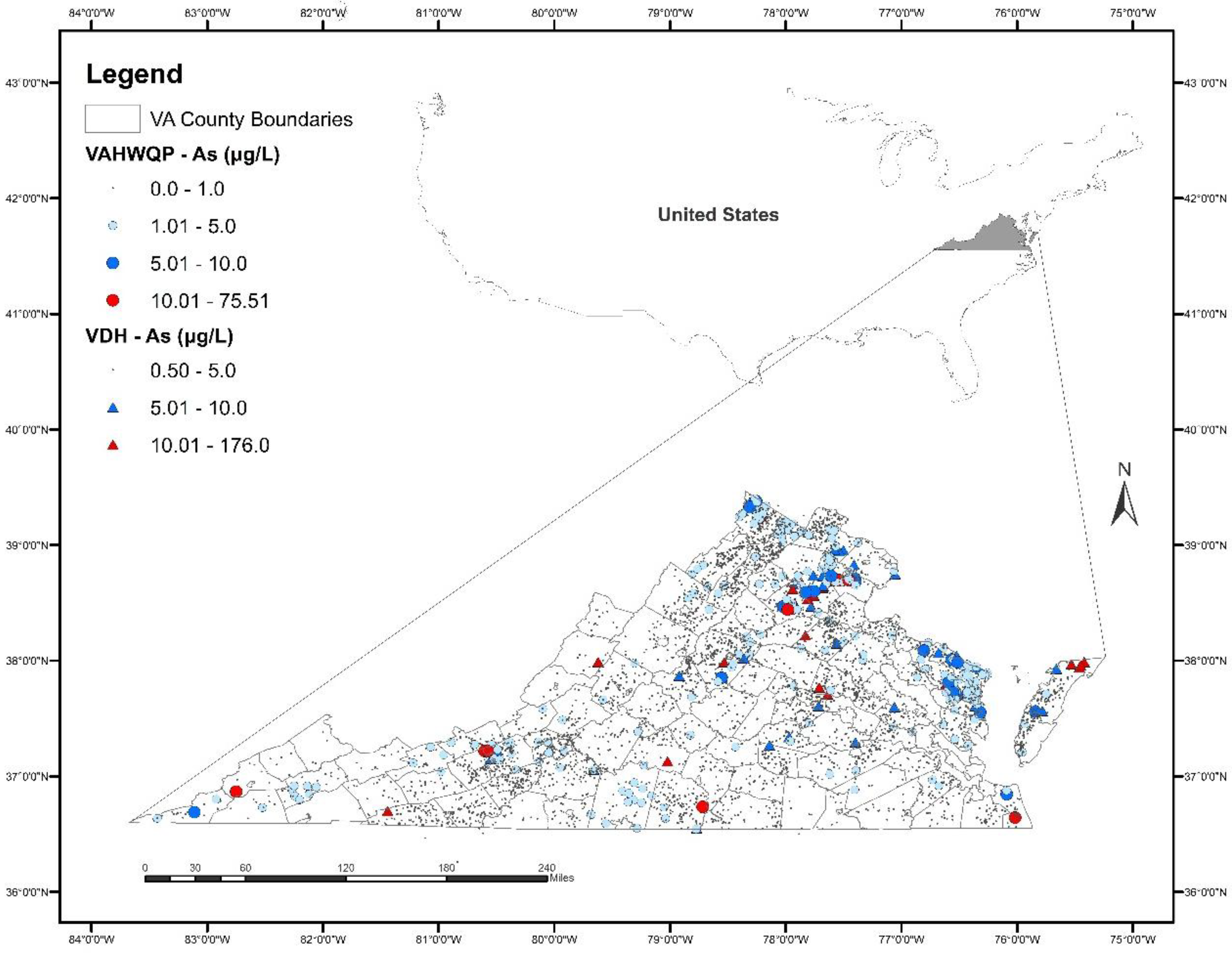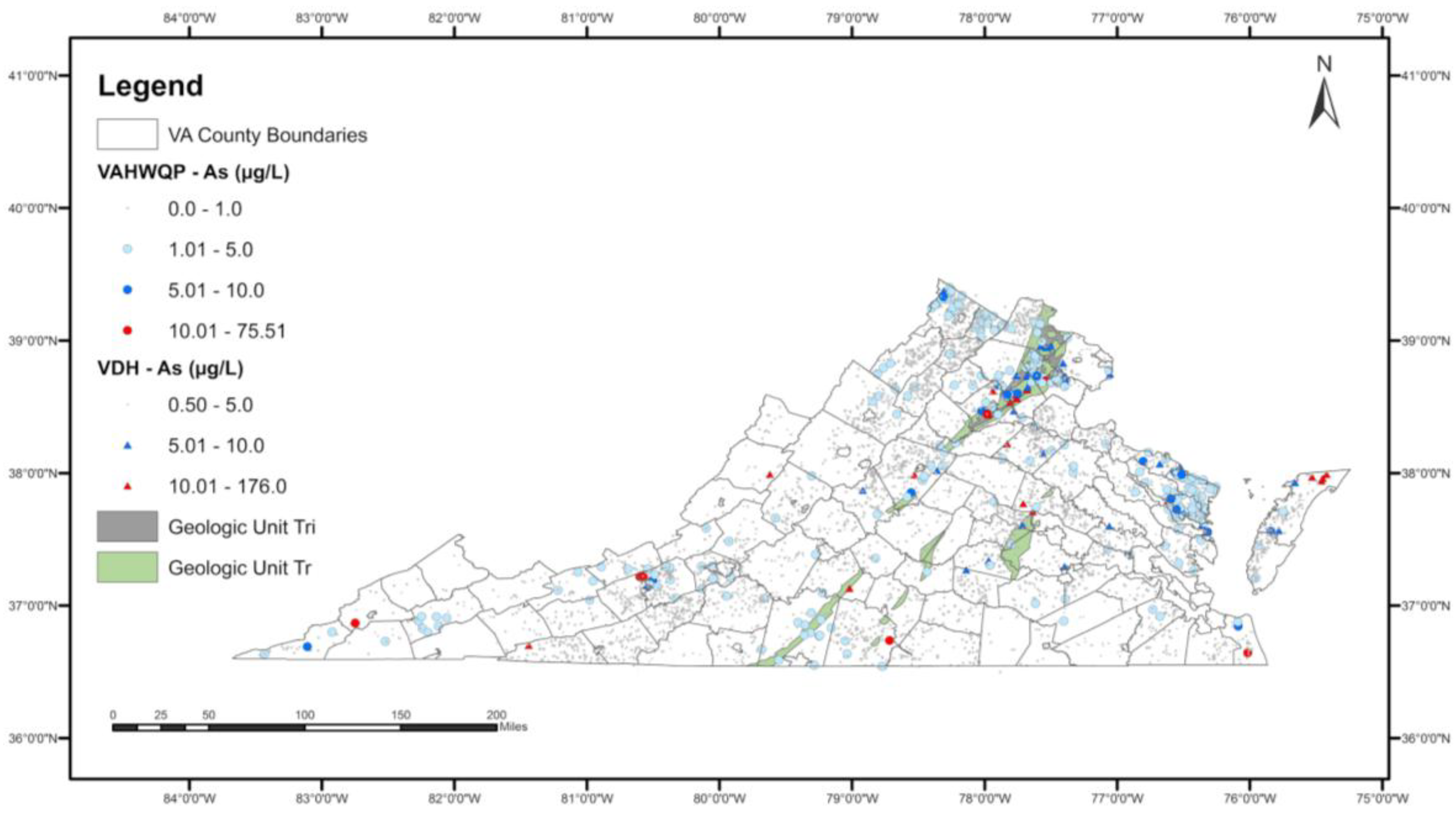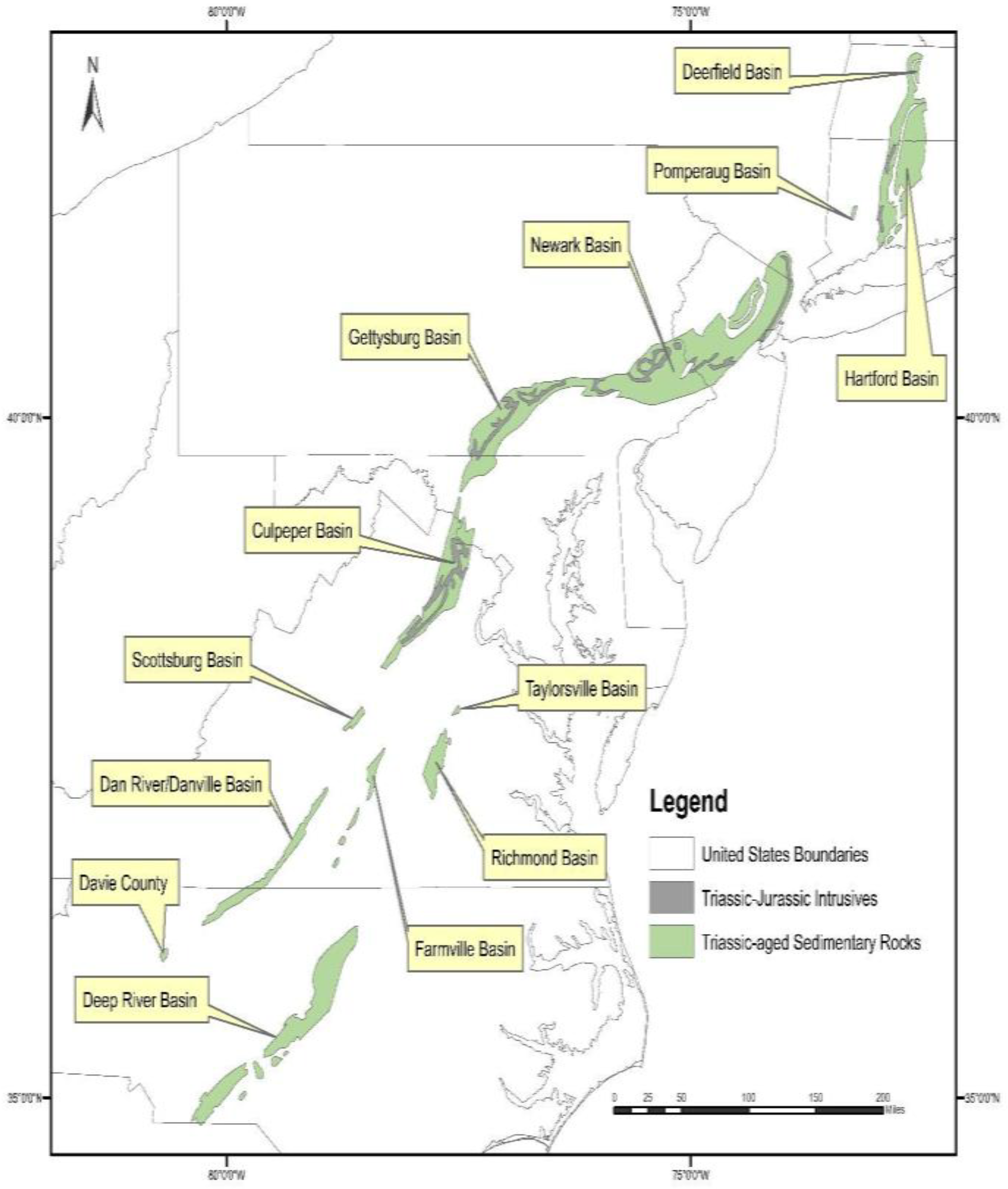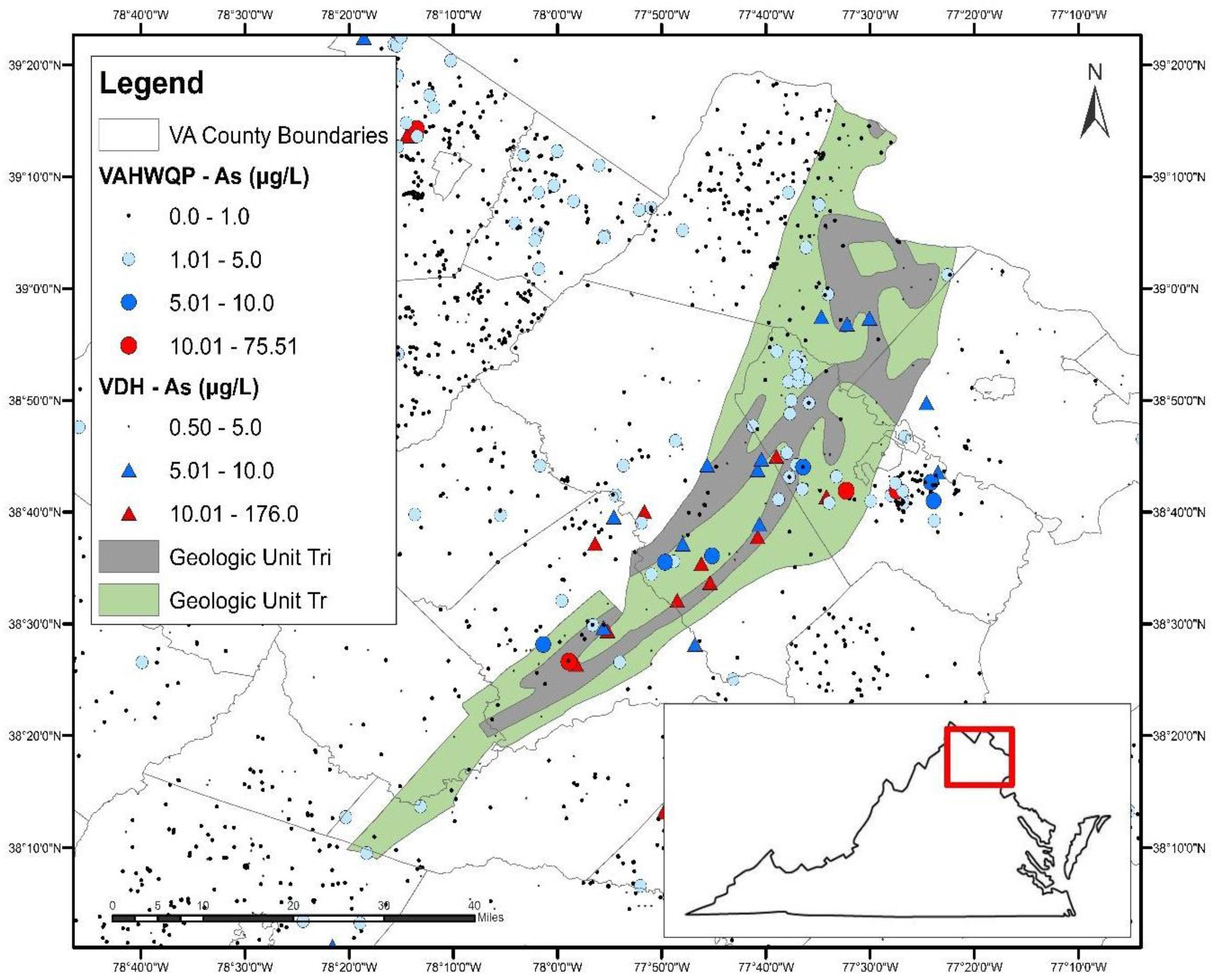1. Introduction
Worldwide, it is estimated that at least 140 million people drink well water with unsafe concentrations of arsenic (As) [
1]. Elevated As concentrations in groundwater occur naturally in many countries [
2], with examples in China [
3,
4], Southeast Asia [
5,
6,
7], Latin America [
8,
9], Africa [
10,
11], the United States [
12,
13,
14], and Canada [
15,
16]. Since As is a known toxin and carcinogen [
17,
18], drinking water standards for As have been established by the World Health Organization (WHO), the European Union (EU), and the U.S. Environmental Protection Agency (USEPA), among other agencies. Currently, the drinking water standard for As set by the WHO, EU, and USEPA is 10 μg/L, although many studies indicate that adverse health effects may be caused by ingesting As concentrations lower than 10 μg/L [
19,
20,
21]. Such adverse health effects include heart disease [
19,
22], complications during pregnancy and quality of life in exposed children [
23], and diabetes [
24,
25].
Arsenic is a component of over 200 naturally occurring minerals including sulfides, oxides, and silicates [
26]. In addition, As can adsorb to mineral surfaces, including metal oxides and clays [
27]. Release of As from these naturally occurring minerals into groundwater can result from mineral dissolution and/or desorption of As from the mineral surface; release can occur under in situ conditions, but can be exacerbated by human activities such as mining. For example, oxidation of As-bearing sulfides has also been linked with elevated As concentrations in groundwater [
28,
29,
30,
31]. Arsenic release to groundwater can also occur through desorption via changes in pH or concentrations of competitive anions, such as phosphate [
32,
33], or changes in As speciation, such as reductive desorption [
26]. The mechanism that has resulted in the most widespread release of As to groundwater is reductive dissolution of naturally occurring As-bearing iron oxides, coupled with oxidation of organic matter [
1,
34,
35,
36]. Recent studies in the Coastal Plain of Maryland and New Jersey suggest that reductive dissolution of As-bearing glauconite may also be responsible for As release to groundwater [
37,
38,
39].
In addition to naturally occurring minerals, there are many anthropogenic sources of As that can locally impact As concentrations in groundwater, including the use of arsenical herbicides and pesticides [
40,
41,
42], animal feed additives [
43,
44,
45], wood preservation [
46,
47], mining activities [
48,
49,
50], waste sites [
13,
51,
52], and other sources including smelter operations, combustion of fossil-fuels, some types of glass production, and disposal of bullets, mildew resistant paints, and lead batteries [
26,
53].
Because As is odorless, colorless, and tasteless, it is difficult for human senses to detect As in water. The primary method for identifying As in well water is through sample collection and analysis. Although public water supplies in the U.S. are regulated under the Safe Drinking Water Act, private wells are not regulated, leaving homeowners with the responsibility for having their wells tested. In addition, well sampling and analysis can be expensive; thus, many homeowners do not regularly sample and test their wells, if at all [
54,
55,
56,
57]. Even when wells are found to have elevated As, it is often difficult to determine which source/sources is/are responsible, creating a challenge for regional-scale groundwater protection. Thus, other approaches for evaluating As risk are needed.
Statistical modeling is one approach that has been used to identify areas susceptible to As contamination and factors that are associated with elevated As in groundwater. Logistic regression, for example, can predict the probability of binary outcomes (e.g., As concentration > 5 μg/L (
Y = 1) vs. As concentration ≤ 5 μg/L (
Y = 0) in groundwater) and can also quantify the importance of different variables, such as geologic formation, soil series, and groundwater chemistry associated with As concentrations. Results of previous studies have demonstrated the utility of logistic regression methods for evaluating the relative importance of geological and environmental factors influencing As in groundwater at regional scales and for predicting As concentrations in groundwater in regions where no sampling data are available [
6,
14,
58,
59,
60,
61,
62,
63,
64].
Although national surveys of As concentrations in groundwater supplies have been conducted in the U.S., e.g., [
13], fewer than 10% of counties in mid-Atlantic states have been included in these surveys [
63]. Evaluation of As in groundwater in Virginia, in particular, has never before been conducted, likely because Virginia has not been identified as an As “hot spot.” However, a recent study [
65] identified elevated As within sedimentary aquifers of the Mesozoic Basins of the eastern U.S. and in metamorphosed clastic sedimentary units of the Piedmont and Blue Ridge aquifers, both of which are present in Virginia. There are 2900 wells in Virginia used for public water supply [
66]. In addition, approximately 1.6 million Virginia residents use private wells [
66]; with a current (March 2018) population of 8.5 million, an estimated 20% of the population uses private well water. Thus, delineating regions with groundwater susceptible to elevated As is a public health concern. The objectives of this study are to evaluate the presence of As in well water in Virginia, to examine the spatial distribution of As concentrations in well water, and to develop a logistic regression model to evaluate if elevated As occurrences are associated with specific geologic units.
2. Materials and Methods
2.1. Arsenic Concentrations in Well Water
For this study, we used state-wide datasets from the Virginia Department of Health (VDH) and the Virginia Household Water Quality Program (VAHWQP;
www.wellwater.bse.vt.edu), a Virginia Cooperative Extension program based at Virginia Tech. We also searched for groundwater quality data from the Virginia Department of Environmental Quality (VADEQ) and the U.S. Geological Survey (USGS), but datasets available from these agencies contained few samples that were analyzed for As or had other issues such as not retaining reporting limits. Chapman et al. [
65] present data on 94 samples in Virginia and had low reporting limits (1 μg/L), but the data represent filtered samples. The datasets we used from VDH and VAHWQP include data for unfiltered samples (see more details below).
Datasets were first checked for duplicate samples. If more than one sample was collected at an individual location, the maximum As concentration for each location was retained and the remainder of the samples were discarded, a method that has been used in similar studies [
14,
62,
67,
68] to allow for preservation of as many “events” (i.e., As concentration > 5 μg/L) and minimize small-sample bias in the model results. Summary information about the datasets is included in
Table 1.
The VDH dataset contains As concentrations from unfiltered samples collected from public water supply wells in Virginia from 1973 to 2013. The original dataset did not include latitude and longitude for the well locations but did include a general location description for each well, which was used to assign spatial location using Google Earth satellite imagery. If locations could not be not clearly identified, the data were discarded. Samples were collected at the wellhead prior to treatment. As a general guideline, wells were pumped for ~15 min prior to sampling. Reporting limits for As measurements were included in the dataset, but the analytical method used to measure As was not. Thirteen samples had a reporting limit exceeding 5 μg/L (As ranging from 6 to 50 μg/L) and were removed from the dataset.
The VAHWQP dataset contains concentrations of As (and other water quality parameters) in water samples collected from wells, springs, and cisterns by homeowners. VAHWQP conducts county-based drinking water clinics across Virginia. Samples were not filtered prior to analysis. Arsenic was analyzed in samples collected from 2008 to 2015. The reporting limit for As samples in this dataset is 1 μg/L. Two samples were collected at each location: a first draw sample and a flushed sample. The first draw sample was collected after stagnation in the plumbing (typically overnight). The flushed sample was collected after water was flushed through pipes for at least 5 min. Data from flushed samples were used in this study, as they likely represent a more accurate depiction of groundwater chemistry with less influence from household plumbing. Homeowner-submitted samples were analyzed and results returned confidentially. In addition to collecting the water sample, homeowners completed a survey that documents the water source (e.g., well, spring, or cistern). We removed samples that were collected from springs and cisterns and only kept samples collected from wells. Homeowners were also asked other questions, including perceived condition of the water (e.g., color, odor, taste), information on water treatment systems, and proximity to perceived potential sources of contamination. We did not remove any samples based on homeowner-supplied information on water treatment, as we were not able to check this information for accuracy.
2.2. GIS Data
Location of each sample in the datasets was mapped spatially in ArcGIS version 10.2.2 in separate project files [
69]. Geologic unit layers were added to each project file to represent environmental attributes. The geologic unit layer (
Figure S1) was obtained from the USGS website (
https://mrdata.usgs.gov/geology/state/state.php?state=VA) as a shapefile. The shapefile includes bedrock geologic unit name, spatial locations, and a short description. These geologic units (160) were classified first by age, then stratigraphy. Stratigraphic units are only used where they illustrate a special geologic feature and where the age of the units is uncertain. In general, most of the geologic systems that form outcrops can be separated into several comprehensive time-stratigraphic units. In the eastern U.S., hybrid nomenclature is used to describe units that form outcrop bands too narrow to be separated, or that the two units form a homogeneous body of rocks.
Other spatial data, including land use, lithology, physiographic province, and soils, were also mapped in GIS and were included in our early modeling efforts but were not used in the final modeling. Initially, we were particularly interested in land use because some human activities, including abandoned mines, landfills, toxic waste sites, golf courses, and historical fruit orchards, may be sources of As. However, upon closer examination of the land use data (see [
70] for more information), we recognized that the land use categories do not include the specific land uses that would be relevant for As and thus, we changed our focus to evaluating geologic sources.
2.3. Model Creation and Variable Selection
The logistic regression model was built to measure the probability that As concentrations exceed a given threshold:
where
P(
Y = 1|
X1, …,
Xk) = is the probability that
Y = 1 occurred; when
Y = 1, a sample has an As concentration greater than the threshold; when
Y = 0, a sample has an As concentration less than or equal to the threshold.
X1,
X2, …,
Xk are the regressors (discussed below), and
β1,
β2, …,
βk are the coefficients. The data were analyzed using the statistical software R [
71]. We utilized Least Absolute Shrinkage and Selection Operator (LASSO) logistic regression [
72] to conduct variable selection and ridge logistic regression [
73] to fit the data to obtain robust inference. Both LASSO and ridge logistic regressions are penalized logistic regressions. Compared with regular logistic regressions, penalized logistic regressions include extra regularization terms in the loss function. The loss function is then minimized to get the estimation of the regression coefficients. The regularization term for LASSO is the sum of absolute values of the regression coefficients (L1 penalty), and the regularization term for ridge is the sum of squared values of the regression coefficients (L2 penalty). LASSO can push the estimated regression coefficients to zero, thus it can be used to conduct variable selection, while ridge can stabilize the variance of the estimated regression coefficients in the presence of multicollinearity. Bootstrap analysis was conducted in the variable selection step (LASSO logistic regression). If a candidate variable (geologic unit) was selected (i.e., non-zero) more than 80% of times among 1000 bootstrap samples, this variable was considered as “significant” and was included in the model-fitting step. We calculated the means and 95% confidence intervals of the coefficients of these significant variables based on 1000 bootstrap samples. In the model-fitting step (i.e., ridge logistic regression), significant regressors were identified using a p-value less than 0.01.
Regressors considered during model selection included the 160 geologic units found in Virginia. These regressors are categorical, which means they have a fixed number of possible values that do not indicate rank or order. These categorical variables were then coded as binary variables or “indicator variables” for each level, following the strategy used by Ayotte et al. [
60].
The final model was constructed using the combined VDH and VAHWQP datasets. In the combined dataset, 98.3% of the 5632 observations used in the model were ≤5 μg/L (threshold for model). Other studies that have one dataset separate the data into two sections (e.g., 85% of data and 15% of data) in order to train and validate the model, respectively (see [
60] for an example). However, due to the low number of samples above the reporting limit (5.9%) and above the threshold (1.7%) in our dataset, using a combined dataset allowed for a more powerful model.
We used 5 μg/L as the threshold to construct our binary response variable because the reporting limits for the datasets were 1 μg/L (VAHWQP) and 5 μg/L (VDH); thus, using a threshold of 5 μg/L allowed us to use concentrations from both datasets. Using a threshold that was higher than the reporting limit (e.g., 10 μg/L, which is the USEPA’s drinking water standard) was tested during model development, but this introduced higher uncertainty, as we had few samples with As concentrations above 10 μg/L.
We evaluated model performance using several methods. False positive rates and false negative rates were computed upon completion of the regression model. Fitted probabilities of elevated As occurrences from the model were obtained, and the probabilities greater than 0.5 were determined to be As concentrations above the threshold (5 μg/L), that is Y = 1, and probabilities less than 0.5 were determined to be As concentrations less than the threshold (5 μg/L), that is Y = 0. True positives, true negatives, false positives, and false negatives were then counted and model performance measures (e.g., false positive rate, false negative rate, sensitivity, and specificity) were computed. We also used the Hosmer-Lemeshow goodness-of-fit test, the mean squared error (MSE), and Pearson residuals to compare the observed to fitted values for the model.









